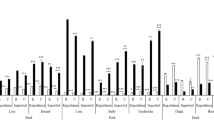Abstract
The present study was focused to investigate the effect of selected spices (turmeric, torch ginger, lemongrass and curry leaves) on the formation of heterocyclic amines (HCAs, IQx, MeIQ, MeIQx, DiMeIQx, IQ, harman, norharman, and AαC) in deep fried lamb meat. Meat samples were marinated with optimized levels of turmeric (4 %), 10 % each of torch ginger, lemon grass, curry leaves at medium (70 °C) and well done (80 °C) doneness temperatures. The concentration of HCAs in deep fried meat samples were analysed using LC-MS/MS technique. The results revealed that torch ginger (10 %) has reduced 74.8 % of Me1Qx (1.39 to 0.35 ng/g) at medium doneness, followed by the 64.7 % reduction, using curry leaves and turmeric at medium degree of doneness. Torch ginger has reduced 86.6 % of AαC (2.59 to 0.40 ng/g) at well done doneness. The most prevalence level of HCAs was found in deep fried meat i.e. DiMeIQ (3.69 ng/g) at well done doneness. The sensory evaluation, using a 7 point hedonic test design for colour and texture in deep fried meat samples were resulted in a preferred color of golden brown and slightly tough texture. The use of local spices in marinating of deep fried lamb meat samples will certainly inhibit/reduce the level of these toxic and harmful HCAs.




Similar content being viewed by others
References
Damašius J, Venskutonis PR, Ferracane R, Fogliano V (2011) Assessment of the influence of some spice extracts on the formation of heterocyclic amines in meat. Food Chem 126:149–156
Gibis M, Weiss J (2012) Antioxidant capacity and inhibitory effect of grape seed and rosemary extract in marinades on the formation of heterocyclic amines in fried beef patties. Food Chem 134:766–774
Gibis M, Kruwinnus M, Weiss J (2015) Impact of different pan-frying conditions on the formation of heterocyclic aromatic amines and sensory quality in fried bacon. Food Chem 168:383–389
Gross GA, Grüter A, Heyland S (1992) Optimization of the sensitivity of high-performance liquid chromatography in the detection of heterocyclic aromatic amine mutagens. Food Chem Toxicol 30:491–498
IARC (1993) Some naturally occurring substances: food items and constituents, heterocyclic aromatic amines and mycotoxins. IARC Monogr Eval Carcinog Risks Hum 56:165–195
Jägerstad M, Skog K (2005) Genotoxicity of heat-processed foods. Mutat Res 574:156–172
Jägerstad M, Skog K, Arvidsson P, Solyakov A (1998) Chemistry, formation and occurrence of genotoxic heterocyclic amines identified in model systems and cooked foods. Z. Lebensm- Unters Forsch A 207:419–427
Jinap S, Iqbal SZ, Selvam RMP (2015) Effect of selected local spices marinades on the reduction of heterocyclic amines in grilled beef (satay). LWT Food Sci Technol 63(2):919–926
Johansson MAE, Jägerstad M (1996) Influence of pro- and antioxidants on the formation of mutagenic-carcinogenic heterocyclic amines in a model system. Food Chem 56(1):69–75
Kizil M, Oz F, Besler HT (2011) A review on the formation of carcinogenic/mutagenic heterocyclic aromatic amines. J Food Process Technol 2:120. doi:10.4172/2157-7110.1000120
Knutsen H, Binderup ML, Vikse R, Øvrebø S (2007) Vurdering af helserisiko ved konsum av grillet mat. Norges Vitenskapskomiteen for Mattrygghet (VKM)
Matsumoto T, Yoshida D, Tomita H (1981) Determination of mutagens, amino-α-carbolines in grilled foods and cigarette smoke condensate. Cancer Lett 12:105–110
Messner C, Murkovic M (2004) Evaluation of a new model system for studying the formation of heterocyclic amines. J Chromatogr B 802(1):19–26
Norat T, Bingham S, Ferrari P, et al. (2005) Meat, fish, and colorectal cancer risk: the European prospective investigation into cancer and nutrition. J Natl Cancer Inst 97:906–916
Oz F, Kaya M (2011) The inhibitory effect of black pepper on formation of heterocyclic aromatic amines in high-fat meatball. Food Control 22:596–600
Quelhas I, Petisca C, Viegas O, Melo A, Pinho O, Ferreira IMPLVO (2010) Effect of green tea marinades on the formation of heterocyclic aromatic amines and sensory quality of pan-fried beef. Food Chem 122:98–104
Sinha R, Rothman N, Brown ED, Salmon CP, Knize MG, Swanson CA, Rossi SC, Mark SD, Levander OA, Felton JS (1995) High concentrations of the carcinogen 2-amino-1-methyl-6-phenylimidazo-[4,5-b]pyridine (PhIP) occur in chicken but are dependent on the cooking method. Cancer Res 55:4516–4519
Smith JS, Ameri F, Gadgil P (2008) Effect of marinades on the formation of heterocyclic amines in grilled beef steaks. J Food Sci 73:100–105
Szterk A (2015) Heterocyclic aromatic amines in grilled beef: the influence of free amino acids, nitrogenous bases, nucleosides, protein and glucose on HAAs content. J Food Compos Anal 40:39–46
Viegas O, Novo P, Pinto E, Pinho O, Ferreira IMPLVO (2012) Effect of charcoal types and grilling conditions on formation of heterocyclic aromatic amines (HAs) and polycyclic aromatic hydrocarbons (PAHs) in grilled muscle foods. Food Chem Toxicol 50:2128–2134
Vitaglione P, Fogliano V (2004) Use of antioxidants to minimize the human health risk associated to mutagenic/carcinogenic heterocyclic amines in food. J Chromatogr B 802:189–199
Author information
Authors and Affiliations
Corresponding authors
Ethics declarations
Conflict of interests
The authors declare that there is no conflict of interests.
Additional information
Research Highlights
• The results revealed that torch ginger (10 %) has reduced 74.8 % of Me1Qx (from 1.39 to 0.35 ng/g) at medium doneness
• Curry leaves and turmeric have reduced 64.7 % of Me1Qx at medium doneness
• However, torch ginger has reduced 86.6 % of AαC (2.59 to 0.40 ng/g) at well done doneness
• The results have shown that most prevalence level 3.69 ng/g was found DiMeIQ in deep fried meat at well done doneness
• The sensory evaluation has showed preferred color of golden brown for deep fried meat
• However, for preferred texture, the results of sensory evaluation revealed slightly tough texture of deep fried meat
Rights and permissions
About this article
Cite this article
S., J., Iqbal, S.Z., Talib, N.H. et al. Heterocyclic aromatic amines in deep fried lamb meat: The influence of spices marination and sensory quality. J Food Sci Technol 53, 1411–1417 (2016). https://doi.org/10.1007/s13197-015-2137-0
Revised:
Accepted:
Published:
Issue Date:
DOI: https://doi.org/10.1007/s13197-015-2137-0




